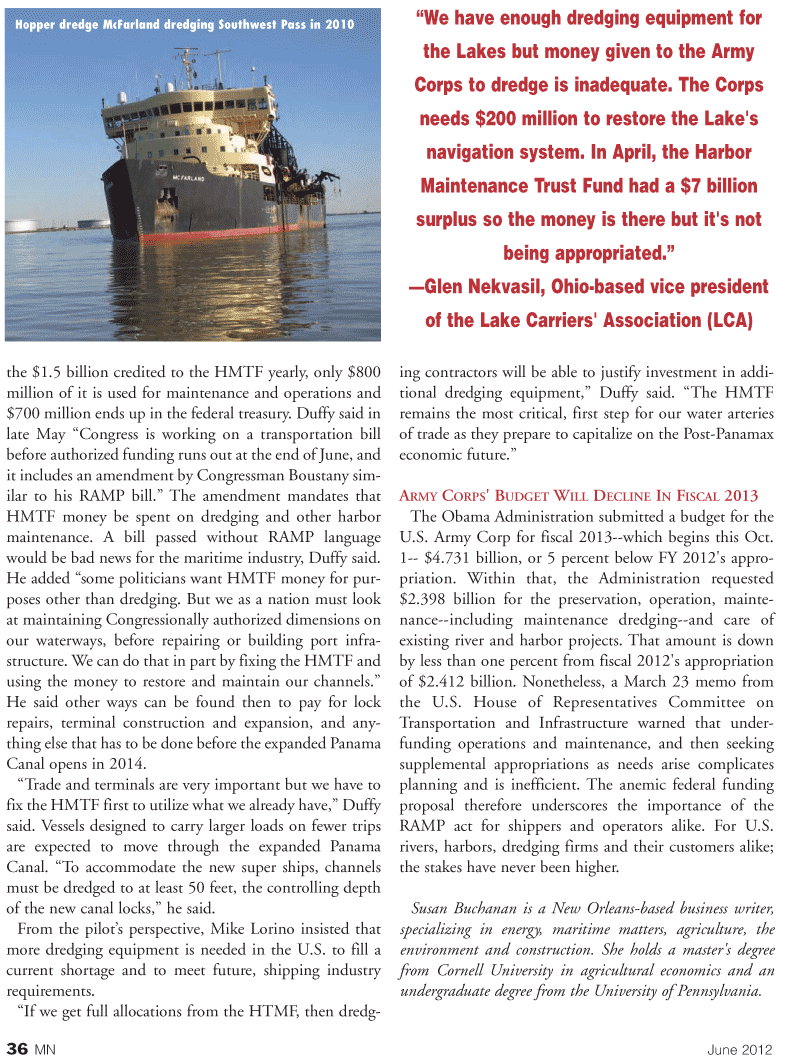
Page 36: of Marine News Magazine (June 2012)
Dredging & Marine Construction
Read this page in Pdf, Flash or Html5 edition of June 2012 Marine News Magazine
36MNJune 2012the $1.5 billion credited to the HMTF yearly, only $800 million of it is used for maintenance and operations and$700 million ends up in the federal treasury. Duffy said in late May Congress is working on a transportation bill before authorized funding runs out at the end of June, and it includes an amendment by Congressman Boustany sim- ilar to his RAMP bill.? The amendment mandates that HMTF money be spent on dredging and other harbor maintenance. A bill passed without RAMP languagewould be bad news for the maritime industry, Duffy said. He added some politicians want HMTF money for pur- poses other than dredging. But we as a nation must look at maintaining Congressionally authorized dimensions on our waterways, before repairing or building port infra- structure. We can do that in part by fixing the HMTF and using the money to restore and maintain our channels.? He said other ways can be found then to pay for lock repairs, terminal construction and expansion, and any- thing else that has to be done before the expanded Panama Canal opens in 2014.Trade and terminals are very important but we have to fix the HMTF first to utilize what we already have,? Duffy said. Vessels designed to carry larger loads on fewer trips are expected to move through the expanded Panama Canal. To accommodate the new super ships, channels must be dredged to at least 50 feet, the controlling depth of the new canal locks,? he said. From the pilots perspective, Mike Lorino insisted that more dredging equipment is needed in the U.S. to fill a current shortage and to meet future, shipping industry requirements. If we get full allocations from the HTMF, then dredg- ing contractors will be able to justify investment in addi- tional dredging equipment,? Duffy said. The HMTF remains the most critical, first step for our water arteries of trade as they prepare to capitalize on the Post-Panamax economic future.? ARMYCORPS' BUDGETWILLDECLINEINFISCAL2013 The Obama Administration submitted a budget for the U.S. Army Corp for fiscal 2013--which begins this Oct.1-- $4.731 billion, or 5 percent below FY 2012's appro- priation. Within that, the Administration requested $2.398 billion for the preservation, operation, mainte- nance--including maintenance dredging--and care of existing river and harbor projects. That amount is down by less than one percent from fiscal 2012's appropriation of $2.412 billion. Nonetheless, a March 23 memo from the U.S. House of Representatives Committee on Transportation and Infrastructure warned that under- funding operations and maintenance, and then seekingsupplemental appropriations as needs arise complicates planning and is inefficient. The anemic federal funding proposal therefore underscores the importance of the RAMP act for shippers and operators alike. For U.S. rivers, harbors, dredging firms and their customers alike; the stakes have never been higher. Susan Buchanan is a New Orleans-based business writer, specializing in energy, maritime matters, agriculture, the environment and construction. She holds a master's degree from Cornell University in agricultural economics and an undergraduate degree from the University of Pennsylvania. We have enough dredging equipment for the Lakes but money given to the Army Corps to dredge is inadequate. The Corps needs $200 million to restore the Lake's navigation system. In April, the HarborMaintenance Trust Fund had a $7 billion surplus so the money is there but it's not being appropriated.? ?Glen Nekvasil, Ohio-based vice president of the Lake Carriers' Association (LCA)Hopper dredge McFarland dredging Southwest Pass in 2010

 35
35

 37
37
